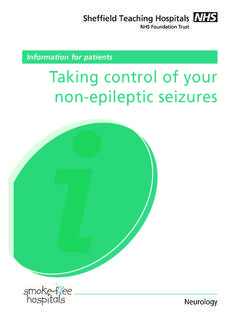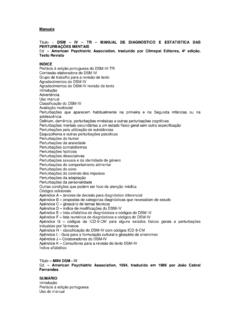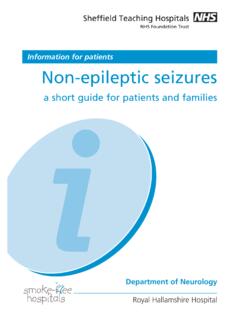Transcription of Non-epileptic seizures
1 Non-epileptic seizures a short guide for patients and families Department of Neurology Information for patients Royal Hallamshire Hospital What are Non-epileptic seizures ? In a seizure people lose control of their body, often causing shaking or other movements of arms and legs, blacking out, or both. seizures can happen for different reasons. During epileptic seizures , the brain produces electrical impulses, which stop it from working normally. Non-epileptic seizures look a little like epileptic seizures , but are not caused by abnormal electrical activity in the brain.
2 Non-epileptic seizures happen because of problems with handling thoughts, memories, emotions or sensations in the brain. Such problems are sometimes related to stress. However, they can also occur in people who seem calm and relaxed. Often people do not understand why they have developed Non-epileptic seizures . Are Non-epileptic seizures rare? For every 100,000 people, between 15 and 30 have non- epileptic seizures . Nearly half of all people brought in to hospital with suspected serious epilepsy turn out to have non- epileptic seizures instead. One of the reasons why you may not have heard of non- epileptic seizures is that there are several other names for the same problem.
3 Non-epileptic seizures are also known as pseudoseizures, psychogenic, dissociative or functional seizures . Sometimes people who have Non-epileptic seizures are told that they suffer from Non-epileptic attack disorder (NEAD). How can I be sure that this is the right diagnosis? Non-epileptic seizures often look like epileptic seizures to friends, family members and even doctors. Like epilepsy, non- epileptic seizures can cause injuries and loss of control over bladder function. However, specialists in the treatment of seizures (neurologists, neurophysiologists or epileptologists) are sometimes able to tell them apart when they are described in detail.
4 For instance, the movements, length, triggers and frequency of Non-epileptic seizures are slightly different from epileptic seizures . In some people, a firm diagnosis of Non-epileptic seizures can be made without any tests. In others, typical seizures can be recorded during an EEG (electroencephalogram) examination. This is a useful test because it can show up the electrical changes, which are only present in epileptic attacks. Home video recordings or even photographs of a typical seizure can sometimes help in the diagnosis. However, the most reliable test is video-EEG monitoring.
5 During this test, we observe patients for several hours or even days with a video camera and an EEG until they have a seizure . By examining the video and EEG recordings, we can make a diagnosis with almost complete certainty. However, video-EEG. monitoring can only be done if a person's attacks are frequent enough (once a week or more). Sometimes we will also use triggers during the test to make it more likely that a seizure occurs. Why was I told that I had epilepsy? More than seven out of ten people with Non-epileptic seizures are treated with anti- epileptic drugs for several years before the correct diagnosis is made.
6 This does not mean that doctors who have treated you for epilepsy have been incompetent. Remember that the diagnosis of seizures relies on the descriptions by observers, who may not have noticed important details. Often the diagnosis becomes clearer over time, when people have had a chance to observe more seizures . Also, epileptic seizures can be very harmful so, to be on the safe side, doctors may decide to start anti- epileptic drugs. They may only recognise that seizures are Non-epileptic when anti- epileptic drugs do not work. What about my abnormal EEG? One in ten completely healthy people have an EEG showing non-specific abnormalities.
7 Such abnormalities can also be caused by anti- epileptic drugs. It is therefore not uncommon that EEG abnormalities are seen in people with Non-epileptic seizures , especially if they are taking anti- epileptic drugs. Another reason why the EEG may be abnormal in a person with Non-epileptic seizures is that some also have epilepsy or other neurological brain disorders. If you have both seizure types, it is important that you and your family learn to tell them apart. What causes Non-epileptic seizures ? We do not know precisely what mechanisms in the brain cause Non-epileptic seizures .
8 Unlike epileptic seizures , Non-epileptic seizures are not the result of physical abnormalities of the brain. Often they are related to emotions or stress, or they result from upsetting experiences, sometimes from the forgotten past. It is well known that emotional stress can produce physical reactions in the body. For example, everyone has blushed in embarrassment or felt their heart thump in their chest when they were nervous or anxious. Today, we also know that more extreme stress can actually cause illness and disability. Non- epileptic seizures , fibromyalgia, chronic fatigue and irritable bowel syndrome are all examples of such disorders.
9 It is important to remember that people with these conditions have real physical symptoms, which are caused by real stresses and that people do not fake them. Often family members (and even health care professionals) do not understand the fact that Non-epileptic seizures are not put on . An upset, such as physical or sexual abuse, divorce, death of a loved one, other great loss or sudden change, recently or in the distant past, often turns out to be the first trigger. What about my other symptoms? These are some other symptoms, which people with non- epileptic seizures can sometimes experience as part of their illness.
10 Often these symptoms have causes similar to non- epileptic seizures . The symptoms are: Numbness, tingling Fatigue Pain Headache Poor concentration Memory problems Poor sleep Difficulty speaking Blurred vision Feeling distant Dizziness Limb weakness Frustration, anger Low mood Worry Panic Bladder problems Bowel problems What can I do to help myself get better? The first step may be the hardest. People often find it very difficult to feel comfortable with the diagnosis of Non-epileptic seizures . It is difficult for them to get better if they are not convinced of the diagnosis.




